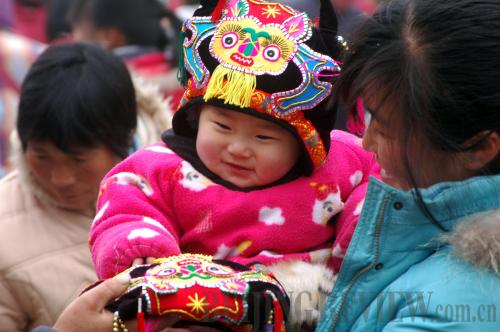|
Since the character for tiger (hu) and the character for happiness (fu) are pronounced similarly in southern dialect, the tiger is also regarded as the emblem of happiness. In Chinese Spring Festival paintings such as Five Happiness, five tigers can be found in the painting.
Another custom still observed in China is that people attach a tiger painting to their door during the celebration of the Spring Festival, the most important traditional festival in China, in the hope of fending off bad luck and bringing good luck.
 |
|
TINY TIGER: A mother chooses a tiger-shaped hat for her child at a market (FANG DEHUA) |
Chinese people also like to use the character for tiger in the names of children who are born in the Year of the Tiger. A boy may be given the name Little Tiger as his childhood name.
In addition to using the character in children's names, Chinese people enjoy having their children accompanied by a representation of a tiger during their childhood. A tiger-shaped pillow is a traditional gift for a newborn baby in the areas along the Yellow River, as the tiger is considered capable of warding off evils and bringing health and blessings. In addition to pillows, cloth toys in the shape of tigers are also popular in the area along the Yellow River, especially in Shanxi, Shaanxi and Gansu provinces. Interestingly, a cloth tiger's face is a combination of many images with which people are familiar. It has fish-like eyebrows, the nose of Renzu, a legendary Chinese ancestor, and sun-like eyes. In ancient times, Shaanxi people observed the tradition that an uncle sends his newly born niece or nephew a yellow cloth tiger toy. While entering the children's room on the day celebrating a baby's completion of its first month of life, the uncle broke off the tiger's tail and threw it out of the door in the hope the baby would grow smoothly without any bad fortune.
Nowadays, the Chinese still like to dress children in all kinds of tiger-shaped clothing including shoes and hats, hoping their children grow up healthy and energetic like tigers.
Loving and worshipping the tiger is a common tradition observed and shared by many ethnic groups in China, including minorities such as Tujia, Yi and Bai. The Tujia ethnic group, distributed in Hunan, Hubei, Sichuan and Guizhou provinces in central and southwest China, highly reveres the white tiger, because they believe they are its descendants. Apart from offering sacrifices, the Tujia people use the images of the white tiger very often in their daily lives to ward off evils. A statue of a white tiger can often be found in the main hall of many Tujia families' houses.
The Yi ethnic group in southwest China's Sichuan and Yunnan provinces also consider themselves the offspring of tigers and they will return to tigers after death. The Tiger Festival is celebrated by the Yi people during January 8-15 of the lunar calendar. During the festival, the Yi people hold a memorial ceremony for tigers and dance in tiger-like costumes.
The Tiger's Characteristics
In the lunar calendar, an animal is used to identify a year in a 12-year cycle and becomes the shuxiang (sign of the birth year) of people born that year. The Spring Festival (the lunar New Year) of 2010 ushered in the Year of the Tiger. Therefore babies born in 2010 and people who were born in 1998, 1986, 1974, 1962, 1950, 1938, 1926 or 1914 have the tiger as their shuxiang. In traditional Chinese belief, people who share the same animal sign, or the same shuxiang, have a similar character, temperament and even fortune in their lives.
Tigers are sensitive, given to deep thinking and capable of great sympathy. But they can be extremely short-tempered. Other people have great respect for them, but occasionally tiger people come into conflict with older people or those in authority. Sometimes tiger people cannot make up their minds, which can result in a poor, hasty decision, or a sound decision made too late. They are suspicious of others, but they are courageous and powerful. Tigers are most compatible with horses, dragons, and dogs.
(Source: c-c-c.org) |

